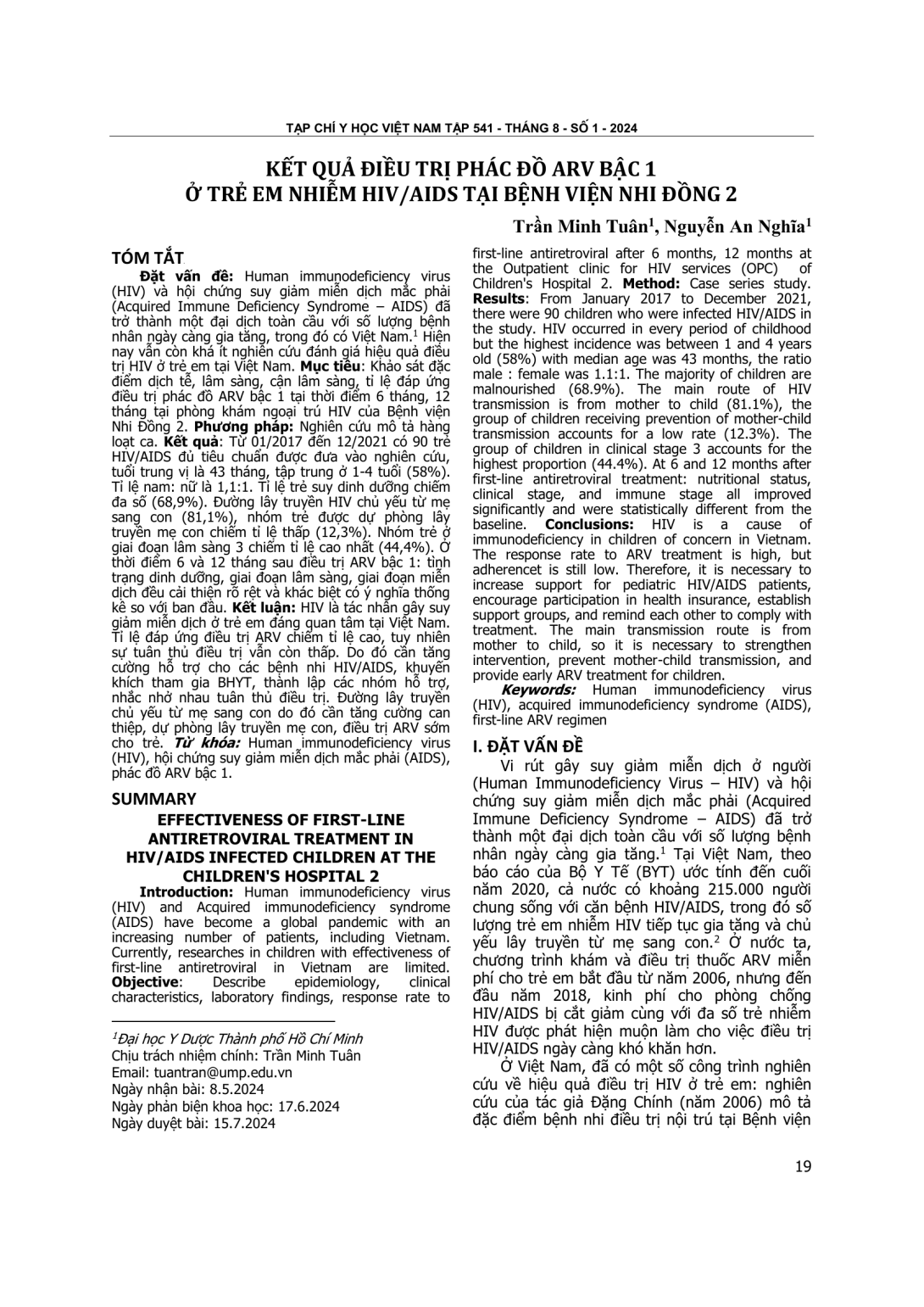
Human immunodeficiency virus (HIV) và hội chứng suy giảm miễn dịch mắc phải (Acquired Immune Deficiency Syndrome – AIDS) đã trở thành một đại dịch toàn cầu với số lượng bệnh nhân ngày càng gia tăng, trong đó có Việt Nam.1 Hiện nay vẫn còn khá ít nghiên cứu đánh giá hiệu quả điều trị HIV ở trẻ em tại Việt Nam. Mục tiêu: Khảo sát đặc điểm dịch tễ, lâm sàng, cận lâm sàng, tỉ lệ đáp ứng điều trị phác đồ ARV bậc 1 tại thời điểm 6 tháng, 12 tháng tại phòng khám ngoại trú HIV của Bệnh viện Nhi Đồng 2. Phương pháp: Nghiên cứu mô tả hàng loạt ca. Kết quả: Từ 01/2017 đến 12/2021 có 90 trẻ HIV/AIDS đủ tiêu chuẩn được đưa vào nghiên cứu, tuổi trung vị là 43 tháng, tập trung ở 1-4 tuổi (58%). Tỉ lệ nam: nữ là 1,1:1. Tỉ lệ trẻ suy dinh dưỡng chiếm đa số (68,9%). Đường lây truyền HIV chủ yếu từ mẹ sang con (81,1%), nhóm trẻ được dự phòng lây truyền mẹ con chiếm tỉ lệ thấp (12,3%). Nhóm trẻ ở giai đoạn lâm sàng 3 chiếm tỉ lệ cao nhất (44,4%). Ở thời điểm 6 và 12 tháng sau điều trị ARV bậc 1: tình trạng dinh dưỡng, giai đoạn lâm sàng, giai đoạn miễn dịch đều cải thiện rõ rệt và khác biệt có ý nghĩa thống kê so với ban đầu. Kết luận: HIV là tác nhân gây suy giảm miễn dịch ở trẻ em đáng quan tâm tại Việt Nam. Tỉ lệ đáp ứng điều trị ARV chiếm tỉ lệ cao, tuy nhiên sự tuân thủ điều trị vẫn còn thấp. Do đó cần tăng cường hỗ trợ cho các bệnh nhi HIV/AIDS, khuyến khích tham gia BHYT, thành lập các nhóm hỗ trợ, nhắc nhở nhau tuân thủ điều trị. Đường lây truyền chủ yếu từ mẹ sang con do đó cần tăng cường can thiệp, dự phòng lây truyền mẹ con, điều trị ARV sớm cho trẻ.
Human immunodeficiency virus (HIV) and Acquired immunodeficiency syndrome (AIDS) have become a global pandemic with an increasing number of patients, including Vietnam. Currently, researches in children with effectiveness of first-line antiretroviral in Vietnam are limited. Objective: Describe epidemiology, clinical characteristics, laboratory findings, response rate to first-line antiretroviral after 6 months, 12 months at the Outpatient clinic for HIV services (OPC) of Children's Hospital 2. Method: Case series study. Results: From January 2017 to December 2021, there were 90 children who were infected HIV/AIDS in the study. HIV occurred in every period of childhood but the highest incidence was between 1 and 4 years old (58%) with median age was 43 months, the ratio male : female was 1.1:1. The majority of children are malnourished (68.9%). The main route of HIV transmission is from mother to child (81.1%), the group of children receiving prevention of mother-child transmission accounts for a low rate (12.3%). The group of children in clinical stage 3 accounts for the highest proportion (44.4%). At 6 and 12 months after first-line antiretroviral treatment: nutritional status, clinical stage, and immune stage all improved significantly and were statistically different from the baseline. Conclusions: HIV is a cause of immunodeficiency in children of concern in Vietnam. The response rate to ARV treatment is high, but adherencet is still low. Therefore, it is necessary to increase support for pediatric HIV/AIDS patients, encourage participation in health insurance, establish support groups, and remind each other to comply with treatment. The main transmission route is from mother to child, so it is necessary to strengthen intervention, prevent mother-child transmission, and provide early ARV treatment for children.
- Đăng nhập để gửi ý kiến
